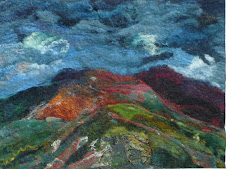I started this on Tuesday night. as I want it for my Dyeing the Blues Workshop on Saturday.
Recipe
The recipe calls for 9 litres of water but I filled up a small stainless steel pot- I think it might be 6litres
60g madder
30g bran
500ml of wood ash lye at pH 14. ( This is the last of my oak ash lye). I put this as even though in proportion it might be too much but somehow I thought it would be okay. and as it turned out the final pH of the solution was 9 verging on 10 which was fine and in fact the one important and critical measurement (along with the temperature)
25g of finely ground indigo.stirred with hot water to a paste. The recipe called for 22g but I had a packet of 25 g so what the hell! It all went in. Would 3g really make a difference?
I boiled the madder and bran , wood ash lye ,and water for twenty minutes, allowed it to cool to 40 degrees C before adding the indigo paste, covered and placed on the heating pad to keep warm. pH was 9. Incidentally a scientifically minded friend though the boiling was to get rid of the alizarin in madder. Certainly the froth goes a fabulous purple or dark red colour.(I have had both colours). On this occasion it was more a dark red.
Wednesday am. The vat was 38 degrees, a few bubbles on the surface. pH 9. Stirred . The vat is starting to smell that characteristic slightly sweet smell
Wednesday pm The vat was 42 degrees pH had dropped to 6. I added 2 tablespoons of sodium carbonate ( washing soda). The pH drops because of the lactic acid produced by fermentation and at this stage you need to check the vat twice a day as pH can drop rapidly as you can see. If the vat becomes acid the vat is described as going sour and the indigotin is lost.Vat smelling
Thursday am The vat was pH 7 I stirred added 2 tablespoons of washing soda, stirred and checked again. pH was now 9.
Thursday pm about 5. The vat had dropped to about pH8 and was nicely warm at 42 degrees C.
I checked it again at 7 ish and it had dropped to Ph 6-7 so I stirred , and added 2 tablespoons of washing soda. I used to make a solution and indeed used to use wood ash lye but this either means adding cold liquid which cooled the vat down or heating it up and now I find adding washing soda works fine. If in doubt as to howmuch to add add a little like a teaspoon , stir and check the pH.
Friday am
Ph7-8 37 degrees C!-it seems to have been really cold overnight as the studio felt really cold this morning to the extent tha\t I discussed with DH lighting the wood burner to take off the chill.
I stirred, added 1 tablespoon of washing soda to pH 9.
The vat had an indigo sheen this morning as well as a slight froth and the sweet fermented smell . I added some newly washed teeswater ( about 25g) down the side of the vat. At first I thought they went an olive green then perhaps a more yellowy colour. Anyway I have left them in till this evening or possibly till tomorrow when the workshop starts.
Friday pm
pH 7-8
Stirred added 1 tablespoon of washing soda. Forgot to takethe temperature.
I have changed the title of my blog- this morning it seemed funny tonight feeling down it seemed offensive. .
I have lost a follower I wonder why?
Madder bran vat day 3.5 sheen of indigo flower on surface
very gradually the fibres turned a darker green but not really a blue.
Saturday
Vat was 35 degrees C PH was 8, so Iadded a tablspoonof washing soda to bring it up to 9 and the little vat dyed all the day coping with 6 students putting two lots of stuff in each. A lot of the fibres still had this strange green cast and my other thought was that there was some yellow dye in the pan left after dyeing otherwise I really cannot account for it. In the evening I just stirred it and left it.
A tidy studio ready for 6 students!
The Blue Table
The results on the airer. The students had 100 g of merino, half a silk cap, some silk chiffon, and could pick from teeswater, silk cocoons, carrier rods.and some yellow merino dyed with Gensita Tinctoria as as well as dyed teeswater. I think everyone had to work quite hard but they all dyed everything in their packs and some managed repeated dips for a darker blue
On the Dyeing the Blues Day. We dyed with fresh woad leaves, fresh Persicaria Tinctoria for blue and in acidulated water for turquoise-hanging at the further end of the airer. We made up a Chemical reduction vat and the students were able to use a fermented vat. The woad was better than I thought but the persicara-grown in Enys's greenhouse - was superb. We did not have time to use the persicaria vat made form my home grown leaves so I am going to use that this morning.
Sunday
Much to my surprise this morning the fermented vat had bubbles on the surface and the pH was 9 Temperature was 36 C.








































